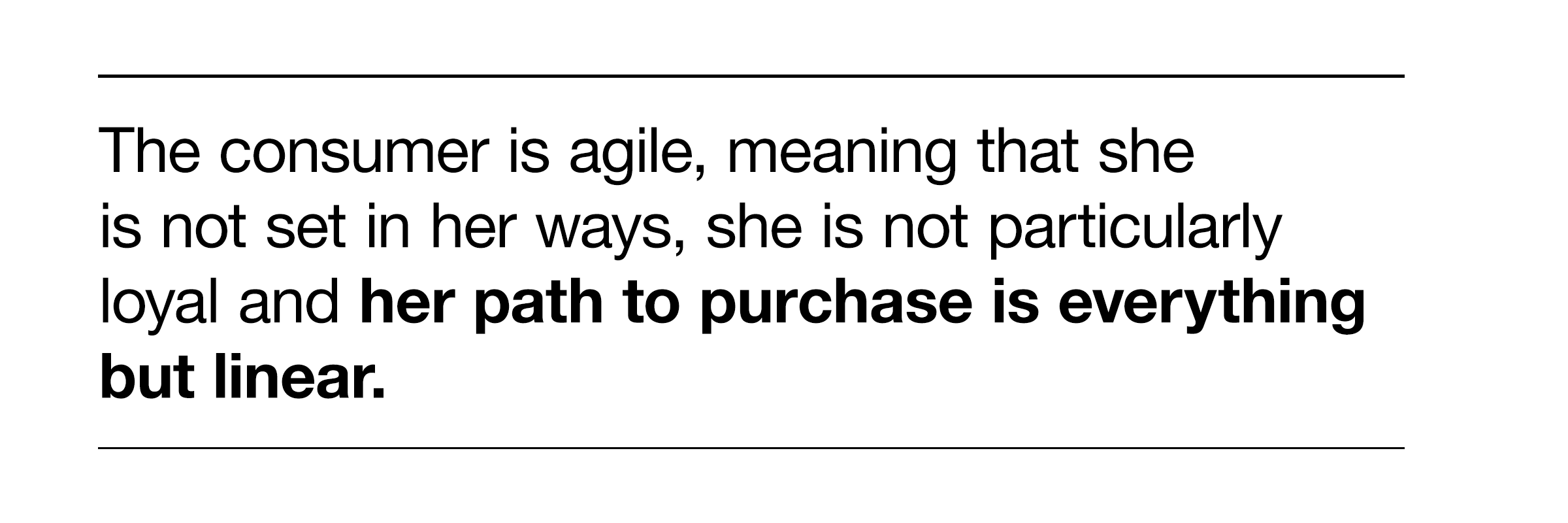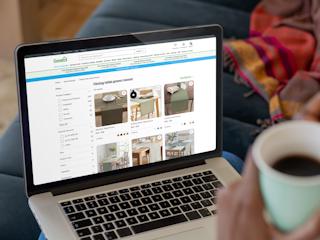31. Oktober 2019
When talking about tech experiences, it is easy to get lost in different tech solutions just because we live in such exciting times. But if we don’t connect tech with the real problem we’re solving, we miss the point. Tech specifics tend to change over time as technology matures, and customer expectations become clearer.
To give an example, we started elaborating with bluetooth beacon technology a couple of years ago, then moved on to exploring RFID-tags, and now we are looking into data matrix bar codes in addition to RFID. The problem space, however, is mostly the same. We want to track people and items in a physical environment so that we can offer better and richer customer experiences and help our clients improve their business KPIs, and ah yes, we also want to support our clients in becoming more sustainable through circular design.

For simplicity, we focus on the concepts of retail being everywhere, instant, personal and circular – areas where advances in technology have gone hand in hand with new customer behaviors.
Everywhere – when every touchpoint is a Point-of-Purchase
As consumers, we want to be able to buy services and products anywhere and everywhere, literally at our fingertips. Every touchpoint is a potential point-of-purchase, and the smart phone is the most powerful of all. Mobile commerce is growing fast, and with solutions such as Samsung Pay and Apple Pay, purchasing is super easy. A recent study in the U.S. reveals that the first digitally native generation, Gen Z’s, spend most of their shopping budget on products they find on Instagram and Snapchat and less than 10% report buying items in a physical store.1
H&M is one of those brands now tying its different touchpoints together.2 With all online markets, you can find in-depth information about each garment, what it’s made of, where it’s produced, the factory name and number of factory workers (helping consumers make informed decisions).3 In-store on several markets you can scan the price tag with the H&M app to locate different sizes, see if it’s available in nearby stores, and complete the purchase in the app. The other night in poor lightning conditions, I took a snapshot of one of my knitted jumpers using the H&M app, and I instantly got two similar suggestions available for purchase at my nearest store and more choices online if I preferred.
Your mission is to find your unique way to connect the dots in your digital ecosystem, which is true to who you are, your purpose and how your customers perceive you.
Instant – “be there when I need you”
It is hard, if not impossible, for physical stores to compete with the instantaneous and convenient shopping online. Instead, retailers and brands need to rethink the role of the store and bring all the benefits of online shopping to the store.

Automated stores such as Amazon Go and the Chinese BingoBox (with over 500 stores in Asia)4 shows what waits around the corner. For those who don’t have the capacity to invest in camera installments, AI with facial recognition and RFID, there are still plenty of areas to explore such as self-service kiosks and empowering your staff with mobile point-of-sales stations, like the ones we have used in the Apple stores.
Personal – understand me and my needs before I have to tell you
Offering a personal shopping experience is way bigger than personalization as we know it. It’s about empowering the consumer to shop the way she prefers and help her make informed decisions. Let’s not forget that some people don’t like shopping at all and that a big chunk of our shopping is mundane groundhog purchases. For some retailers, it could be game-changing to look into the subscription market, which has grown in the U.S., with over 100% per year in the past five years.5 For others, it is all about enticing that emotional connection that a physical meeting between brand and customer. The challenge for retailers and brands alike is to accommodate all these different needs that vary depending on the context.

One interesting company to look into is b8ta, who offers a retail-as-a-service-platform. They turn the market upside down with a flat monthly fee paid by the product manufacturer to the retailer, including everything from staffing, merchandising, point-of-sales to hefty data analytics. In-store cameras will track metrics around foot traffic, and in-store “b8ta testers” will collect information from shoppers. This gives the product manufacturer complete insight into how consumers interact with their products, which can then be used for product development.6
Circular – help me do the right thing and feel good about buying your products
The concept of circular economy involves all stages of the product life cycle from the product design and production process, through marketing and consumption to waste management, recycling and reuse. Companies need to figure out how to make products more durable, easier to repair, collectible and then reused in production once the initial lifespan is over. This is the most difficult and most important of all missions for retailers and brands in the years to come. Some brands are walking the talk, among those H&M with the goal to only use recycled or sustainably sourced materials in its collections by 2030.
In broad brushstrokes, we need to move the focus from products to services and from consumption to experiences. Profoto, providing premium lightning products to photographers across the globe, entered the D2C-market with online sales. To tighten the relationship to its end-customers, Profoto Academy, an online tutoring subscription service for photographers was launched. An excellent example of creating new sticky, digital services in addition to selling products. If you aren’t already looking at your business through circular design lenses, start now! Innovate around new services that enrich your offering and create new revenue streams in addition to your products.







